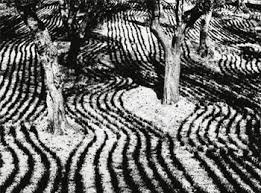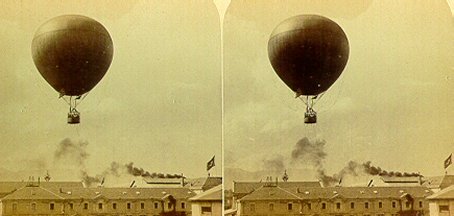Casper David Friedrich 'Monk by the Sea' 1808 - 1810
A lone figure gazing out an an expanse of sea. Most of us have gazed out to sea and gained a sense of the vastness of the world, of the universe - this is the sublime. Casper David Friedrich breaks the whole world down to three elements - the blank foreground of land (earth), the blackish murky sea (water) and the vast empty bruise like sky (Air). It is almost abstract if seen through half closed eyes. It could be a late period Rothko with the same elements of bleakness and emptiness.
This is a late period Rothko, created a year before the artist committed suicide. It displays the dark color palette the artist primarily used during his last years of life, a period that was said to be increasingly lonely and isolating for the artist. His earlier work is much more colourful - the colours affect you on a visceral level - here's one now to cheer you up.Earth
Water
clouds
Menashe Kadishman - 'Cracked Earth' 1973 - 1974
Edward Weston - 'Cracked Earth Borego CA'
Some images are destined to be taken again and again. The image of cracked earth, baked by the sun, life less - it is an iconic image. It speaks of despair and the inability to grow food for living - just looking at these images make you thirsty. On a purely abstract level they create geometric patterns - it is like finding mathematics in nature.
'Rock Formations Detail, Weston Beach, Point Lobos State Reserve, California', 1949 by Philip Hyde.
Brett Weston 'Untitled, Rock Formation', 1968
Mario Giacomelli
The patterns created by the grooves in the earth have been captured by Mario Giacomelli. Giacomelli was a true local, tied to his region, town, and its rhythms and traditions. He was self taught and even in his artistic expression he was influenced by his homeland. We can see this in his landscapes showing signs of man’s labour, with folds like wrinkles on a person’s hands, landscapes that speak of faces and things living in the soul. The story goes that Giacomelli would borrow his neighbors tractor to make the tracks go in another direction to create the perfect graphic, semi abstract photograph. He printed all his work in a trade mark high contrast style. For Giacomelli, photography was above all love, the image telling a poem of the heart which continues to surprise and move us (he originally trained as a poet and a painter).
Water
Clifford Ross - from the 'Hurricane' series
Water is transformed into a stationary solid form and has been frozen in time. The rich black obliterates the sea and sky creating a solid area of negative space to contrast with the white textured area. Ross' images seem to be a heightened form of the real world - these are waves but they seem to be perfect solid waves.
Ernst Haas 'Droplets on an Autumn leaf' 1964
Nature provides its own lenses to bring veins of the leaf into closer view. The lenses are droplets of water that appeared on the leaves in the cool mist of September.
Ernst Haas 'Pine Needles in Ice' 1967
Autumn turns to Winter. The frozen bubbles captured and preserved before they reached the surface. Haas used his camera to peer closely at ordinary subjects to find beauty. Pine needles, positioned towards the right hand side of the frame, divide up the composition. Bubbles form circles of different sizes to contrast with the vertical needles. A photograph preserves a moment in time, frozen forever. Frost and ice also affects the process of time.
Simple net sails of a boat overlap to create a delicate pattern.
Paul Caponigro 'Frost Window No.2' 1961
A picture of frost crystals on a bedroom window makes a tapestry out of a mixture of pattern and texture. Positioning his view camera about 30cm from the glass, the photographer stopped the lens all the way down to f32 so as not to loose the dark trees in the background.
Marc Quinn 'Self ' 1991
This is a a self-portrait head made from the artists own frozen blood. He had to take the blood out in stages and he exhibits it in a refrigerator.
It has the same quality as a traditional death Mask - cast after the subject has passed away. It’s hard to believe that this face once made Europe quake. This is Napoleon's death mask, in the British Museum in London. His steely determination and spark of dynamism have dissolved. His eyes are sunken, his cheek hollow, his lips hang slightly ajar. It’s a fallen face, and the story it tells is of defeat and exile.
Still from Hitchcock's 'The Ring' 1927 - a moving reflection in a stream
During the filming of Hitchcock's early silent film The Ring (1927) he experimented with trick photography. In the above still we see a reflection of a couple in a stream. When the water ripples the image itself ripples and the figure go in and out of abstraction.
Irvin Penn
Droplets of water have been caught in the delicate stems of a dandelion clock. The flower has been back lit to create a simple silhouette. There is a contrast between the sharp translucent circular water droplets and the soft tonal quality of the silhouetted stems.
Adam Fuss 'Untitled' Photogram 2007
Adam Fuss has made a photogram by getting a snake to more through water. The patterns created by the creature moving through the water has been captured directly onto the photographic paper.
M.C. Escher 'Rippled Surface' 1950
M.C. Esher has created the illusion of the rippling surface of water. He has carved into a surface, inked it up and taken a print from it. The raised areas of the surface have left a mark - creating the black ripple effect. There our elements of science and mathematics to Escher art and a fascination in optical illusions.
'Hand with Reflecting Sphere' M. C. Escher 1935
M C Escher
Air
Warhol - Silver Cloud installation
'Clouds, Death Valley, 1938' Edward Weston
Clouds are transient - they appear and disappear in minutes. In the vastness of time they exist as long as human lives - briefly. And given enough time they will leave no trace.
An ephemeral cloud formation becomes a permanent structure in this above image.
Ansel Adams was a giant of 20th century photography. He was a founding member of The f64 Group. F64 refers to their use of a very small aperture – creating very detailed and objective maximum depth of field shots. A tripod would have been used to create these shots as the small aperture means a slower shutter speed is needed.
The objective, detailed results represented the new Modernist aesthetic – cold harsh reality over sentimental pictorialism.
Cloud illustration. German selections from a German cloud atlas In: "Wolken und andere Erscheinungen....", Thomas Forster, 1819
Michelangelo's last judgement sistine chapel 1536 to 1541
Alec Soth 'Bonnie with a portrait of an angle'
clouds
balloons
Jeff Koons
Fire
Cornelia Parker - 'My Soul Afire' 1997A Burnt hymnal retrieved from a church in Lytle, Texas that was struck by lightening. It is a modern relic made more interesting with its back story. We often give inanimate objects meaning by associating them with memories or other times. Cornelia Parker uses sculpture, film, drawings, photographs and objects. Parker is like an archaeologist collecting the waste from our modern world. Parker’s compelling transformations of familiar, everyday objects investigate the nature of matter and test physical properties. Using materials that have a history loaded with association, a feather from Sigmund Freud’s pillow for example, Parker has employed numerous methods of exploration – suspending, exploding, crushing, stretching objects and even language through her titles – transporting them to a realm between two state
Cornelia Parker - 'Anti Mass' 2005
"Anti-Mass" by Cornelia Parker is the Charred remains of a arsoned African American Baptist Church in Alabama. Sculpture is usually a solid mass, carved into and rooted on the floor by gravity. It is sculptures physicality that gives it presence. Parker suspend object in mid air - as if caught in mid explosion or atoms.
The burnt out remains of a Victorian Hall 1919
Fire destroys and leaves nothing behind. A photograph preserves and captures the world that is destined to disappear. A photograph of a burnt out building seems a strange juxtaposition.





































